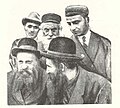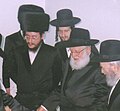
Vizhnitz is the name of a Hasidic dynasty founded by Rabbi Menachem Mendel Hager. Vizhnitz is the Yiddish name of Vyzhnytsia, a town in present-day Ukraine.

Nadvorna is a Hasidic rabbinical dynasty deriving its name from the town of Nadvorna, (Nadvirna), today in Ukraine.

Rachmastrivka is a Hasidic dynasty named after the town of Rotmistrivka, Ukraine. It is an offshoot of the Chernobyl dynasty dating back to the 19th century.

Spinka is the name of a Hasidic group within Haredi Judaism. The group originated in a city called Szaplonca, in Máramaros County, Kingdom of Hungary.

Chernobyl is a Hasidic dynasty which was founded by Grand Rabbi Menachem Nachum Twersky, known by his work as the Meor Einayim. The dynasty is named after the northern Ukrainian city of Chernobyl, where Rabbi Nachum was the maggid. The lineage continues to exist, although not always with the name Chernobyl. Several rebbes are named Chernobyl. The central court is in Bnei Brak, headed by Rabbi Menachem Nachum Twersky.
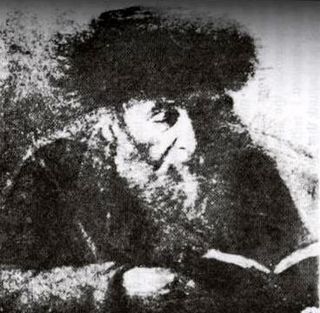
Sanz is a Hasidic dynasty originating in the city of Sanz in Galicia. The dynasty was founded by the rebbe Rabbi Chaim Halberstam (1793–1876) who was the rabbi of Nowy Sącz and the author of the work Divrei Chaim by which name he is known as well.

Biala is a Hasidic dynasty originating from the city of Biała Rawska, where it was founded by R. Yaakov Yitzchak Rabinowicz (II). Biala is a branch of Peshischa Hasidism, as R. Yaakov Yitzchak Rabinowicz (II) was the great-grandson of R. Yaakov Yitzchak Rabinowicz, the first Peshischa Rebbe. The dynasty was originally spread throughout many towns in Poland, often taking the names of said towns. However, after the Holocaust, the name "Biala" become synonymous with the entire dynasty. Today the dynasty is mostly concentrated in Israel, America and Switzerland.

Boyan is a Hasidic dynasty named after the town of Boiany in the historic region of Bukovina, now in Ukraine. The Hasidut is headquartered in Jerusalem, with communities in Beitar Ilit, Bnei Brak, Manchester, Australia, Beit Shemesh, London, Antwerp, Manhattan, Brooklyn, Los Angeles, Monsey, Lakewood, and Atlanta. Boyan is one of the branches of the Ruzhiner dynasty, together with Bohush, Chortkov, Husiatyn, Sadigura, Kapishnitz, Vaslui and Shtefanesht.
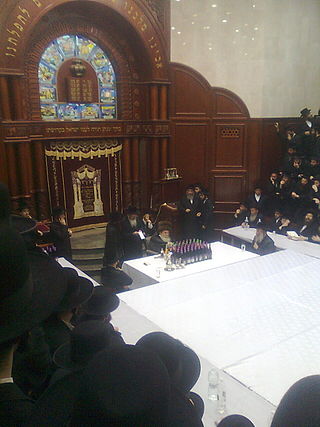
Sadigura is a Hasidic dynasty named for the city of Sadhora, Bukovina, which was part of the Austrian Empire. The dynasty began in 1850 with Rabbi Avrohom Yaakov Friedman, a son of Rabbi Yisrael Friedman of Ruzhyn, and was based in Sadigura until 1914. During the interwar period the dynasty was led by rebbes in Vienna and Przemyśl, Poland, and just before World War II moved to Israel.

Narol is a dynasty of Hasidic rebbes originally based in the village of Narol, W. Galicia.
Kretshnif is a dynasty in Hasidic Judaism that comes from the Nadvorna dynasty, named for Crăciunești in present-day Romania. The founding rebbe was Meir Rosenbaum, a son of Mordechai, rebbe of Nadvorna. His sons and successors included Eliezer Zev in Kretshnif and Sighit, and Issamar of Nadvorna in Chernowitz. The descendant rabbis of this dynasty are mainly in Israel, New York City, England, and Canada.

Har HaMenuchot is the largest cemetery in Jerusalem. The hilltop burial ground lies at the western edge of the city adjacent to the neighborhood of Givat Shaul, with commanding views of Mevaseret Zion to the north, Motza to the west, and Har Nof to the south. Opened in 1951 on 300 dunams of land, it has continually expanded into new sections on the northern and western slopes of the hill. As of 2008, the cemetery encompasses 580 dunams in which over 150,000 people are buried.
Lublin is a Hasidic dynasty founded by Rabbi Yehuda Leib Eiger of Lublin, a town in Poland. It is a branch of Izhbitza-Radzin Hasidus.
Grand Rabbi Gershon Chanoch Henech Leiner of Radzyn was a rebbe of the Izhbitza – Radzin dynasty, and the first to be known as "the Radzyner Rebbe".
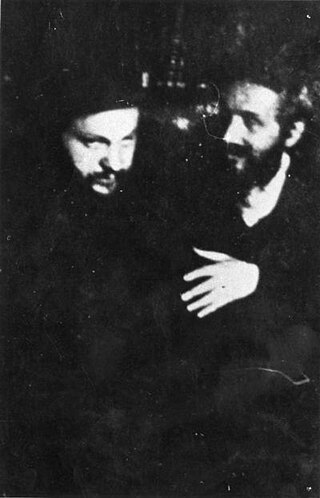
Grand Rabbi Shmuel Shlomo Leiner (1909–1942) was the Radziner Rebbe.
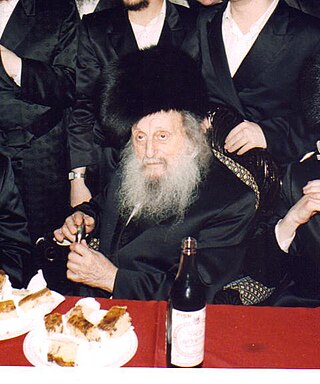
Grand Rabbi Avraham Yissochor Englard of Radzin, was a scion of Radomsk and the Chief Rabbi of Sosnowiec.

Grand Rabbi Shlomo Yosef Englard is the current Radziner Rebbe. He is considered an authority on Tekhelet and Rabbinic genealogy

Rabbi Nosson Nochum Englard of Radzin-Yerushalayim is a scion of Radomsk and the rabbi of the Radziner hassidim in Jerusalem.
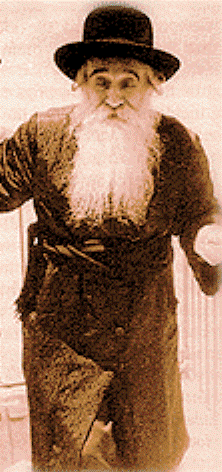
Mordechai Shlomo Friedman, sometimes called Solomon Mordecai Friedman, was the Boyaner Rebbe of New York for over 40 years. In 1927 he left Europe to become one of the first Hasidic Rebbes in America, establishing his court on the Lower East Side of New York City and attracting many American Jewish youth with his charismatic and warm personality. He also played a role in American Jewish leadership with positions on Agudath Israel of America, the Moetzes Gedolei HaTorah, and Holocaust rescue organizations. In 1957 he built the flagship Ruzhiner yeshiva, Tiferet Yisroel, at the top of Malkhei Yisrael Street in Jerusalem.

Radomsk is a hasidic dynasty named after the town of Radomsko in Łódź province, south-central Poland. The dynasty was founded in 1843 by Shlomo Hakohen Rabinowicz. His son, grandson and great-grandson also led the dynasty, which had thousands of followers. On the eve of World War II, Radomsk was the third largest Hasidic dynasty in Poland, after Ger and Alexander.











